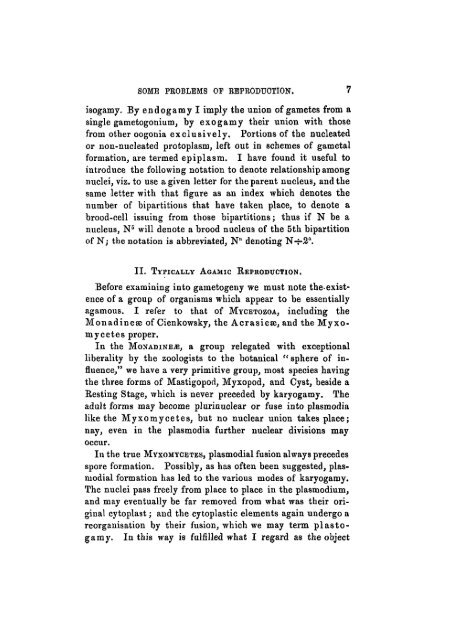Some Problems of Reproduction: a Comparative Study of ...
Some Problems of Reproduction: a Comparative Study of ...
Some Problems of Reproduction: a Comparative Study of ...
You also want an ePaper? Increase the reach of your titles
YUMPU automatically turns print PDFs into web optimized ePapers that Google loves.
SOME PROBLEMS OP REPRODUCTION. 7<br />
isogamy. By endogamy I imply the union <strong>of</strong> gametes from a<br />
single gametogonium, by exogamy their union with those<br />
from other oogonia exclusively. Portions <strong>of</strong> the nucleated<br />
or non-nucleated protoplasm, left out in schemes <strong>of</strong> gametal<br />
formation, are termed epiplasm. I have found it useful to<br />
introduce the following notation to denote relationship among<br />
nuclei, viz. to use a given letter for the parent nucleus, and the<br />
same letter with that figure as an index which denotes the<br />
number <strong>of</strong> bipartitious that have taken place, to denote a<br />
brood-cell issuing from those bipartitions; thus if N be a<br />
nucleus, N 5 will denote a brood nucleus <strong>of</strong> the 5th bipartition<br />
<strong>of</strong> N; the notation is abbreviated, N" denoting N-r-2 a .<br />
II. TYPICALLY AGAMIC REPRODUCTION.<br />
Before examining into gametogeny we must note the-existence<br />
<strong>of</strong> a group <strong>of</strong> organisms which appear to be essentially<br />
agamous. I refer to that <strong>of</strong> MYCETOZOA, including the<br />
Monadineae <strong>of</strong> Cienkowsky, the Acrasiese, and the Myxomycetes<br />
proper.<br />
In the MONADINEJE, a group relegated with exceptional<br />
liberality by the zoologists to the botanical " sphere <strong>of</strong> influence,"<br />
we have a very primitive group, most species having<br />
the three forms <strong>of</strong> Mastigopod, Myxopod, and Cyst, beside a<br />
Resting Stage, which is never preceded by karyogamy. The<br />
adult forms may become plurinuclear or fuse into plasmodia<br />
like the Myxomycetes, but no nuclear union takes place;<br />
nay, even in the plasmodia further nuclear divisions may<br />
occur.<br />
In the true MYXOMYCETES, plasmodial fusion always precedes<br />
spore formation. Possibly, as has <strong>of</strong>ten been suggested, plasmodial<br />
formation has led to the various modes <strong>of</strong> karyogamy.<br />
The nuclei pass freely from place to place in the plasmodium,<br />
and may eventually be far removed from what was their original<br />
cytoplast; and the cytoplastic elements again undergo a<br />
reorganisation by their fusion, which we may term plastogamy.<br />
In this way is fulfilled what I regard as the object

















